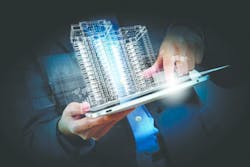Overall connectivity penetration rates across all building systems are currently only around 16 percent. This connectivity penetration rate will, of course, rise steadily over the coming years, and with it the market potential for the Internet of Things in Buildings (BIoT). Memoori’s new report projects that the global market for the BIoT will increase from approximately $23 billion in 2014 to over $85 billion in 2020.
The networking and related services segment of the market will show a steady growth of 22.6 percent CAGR rising to $32 billion in 2020, which will represent 37 percent of overall revenues by 2020. Effective network deployment, in order to keep up with the rising bandwidth demands of the BIoT, will be crucial to the efficient delivery of services and the management of data flows.
The value in the Internet of Things is as much in the data as the device. Collecting data from more building services and equipment will provide a much more granular view of exactly how each building is performing. Building equipment manufacturers and providers must start selling systems that collect, store and analyze data in the cloud, so they can use it to provide better operational efficiency for their clients.
The analysis of big data is central to this proposition, and depends on cutting-edge software technologies not commonly available in the average enterprise, including massively parallel processing databases (MPPs), data-mining grids, distributed file systems and distributed databases.
The physical security market already enjoys some of the highest levels of Internet and wireless connectivity of all building services. This market includes intruder alarms, video surveillance and access control systems, using biometric, card-based RFID and wireless smart locks.
Examples of existing BIoT applications relevant to physical security include:
- Video surveillance and the business enterprise: Video Surveillance was first used to monitor public and private space to detect crime and behavior. Since the introduction of IP cameras, they have also been increasingly used to improve the performance of the business enterprise in vertical markets such as retail (e.g. using data gathered from camera footage to optimize retail store layouts).
- Video motion detection and facial recognition: Security cameras interacting with motion sensors and facial recognition databases to improve security and restrict access to sensitive building areas.
- Video Surveillance-as-a-Service (VSaaS): Managed data services that transfer the monitoring and storage of video to the cloud. VSaaS streamlines security operations by centralizing IT and requires no capital investment in servers, but has heavy bandwidth requirements.
- IP-based video management services: Allowing for remote detection and tracking of people and vehicles around a building.
- Biometric access controls, personal identification verification (PIV) and tracking: Using a variety of methods including fingerprint scanning, retinal scanning and even vascular pattern recognition to improve security in buildings.
- Remote control of building access and security: Such as video-intercom systems patching through to a mobile phone or centralized control center rather than to a manned reception desk.
For more information on “The Internet of Things in Smart Buildings 2014 to 2020” report from Memoori, visit http://www.memoori.com/portfolio/internet-things-smart-buildings-2014-2020.



